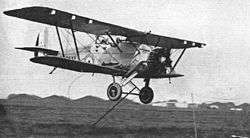Armstrong Whitworth Atlas
| Atlas | |
|---|---|
 | |
| Role | Army cooperation aircraft |
| Manufacturer | Armstrong Whitworth |
| First flight | 10 May 1925 |
| Introduction | 1927 |
| Retired | 1935(RAF), 1942(RCAF) |
| Primary users | Royal Air Force Royal Canadian Air Force |
| Produced | 1927 - 1933 |
| Number built | 478 |
The Armstrong Whitworth Atlas was a British single-engine biplane designed and built by Armstrong Whitworth Aircraft. It served as an army co-operation aircraft for the Royal Air Force (RAF) in the 1920s and 1930s. It was the first purpose-designed aircraft of the type to serve with the RAF.
Development
The Armstrong Whitworth Atlas was designed by a team led by John Lloyd, chief designer of Armstrong Whitworth Aircraft, as a replacement for the DH.9A and Bristol Fighter as an army co-operation aircraft for the RAF, in parallel with the related aircraft, the Ajax and Aries. The Atlas was intended to meet the requirements of Specification 20/25.
The prototype Atlas (G-EBLK) was built as a private venture, first flying on 10 May 1925.[1] It was delivered to the Aeroplane and Armament Experimental Establishment (A & AEE), Martlesham Heath, where it was evaluated against the Bristol Boarhound, de Havilland Hyena, Vickers Vespa, and Short Chamois. It proved superior in performance and handling and was recommended for production.
While the performance was generally good, the prototype could not be sideslipped steeply, and this resulted in a redesign where sweptback metal wings, with differing wing section, were fitted. When tested again, the Atlas was found to have lost its good handling, having dangerous stall characteristics. The Atlas had already been ordered for service, however, and suffered a number of accidents during takeoff and landing in the first few months of operation until modified with automatic slats and increased sweepback. This cured the poor handling.[2]
The production Atlas had a steel tube fuselage with fabric covering with single-bay swept metal wings. It could be fitted with a hook under the fuselage to pick up messages and could carry a 460 lb (210 kg) bombload under the wings.

Operational history
The first batch of 37 aircraft were ordered in 1927, entering service with 13 Squadron RAF and 26 Squadron in that year.[1] Once the initial handling problems had been solved by the fitting of slats, the Atlas proved well suited to the army co-operation role, serving both at home and overseas, with 208 squadron, being the first squadron to operate Atlases outside Britain, replacing Bristol fighters at Heliopolis, Egypt in 1930.[3]
Atlases were also used for communications duties[3] and as advanced trainers, with 175 dual-control models built.[4]
The Atlas continued in service in the army co-operations role until replaced with the Hawker Audax, a variant of the Hawker Hart, with the last operational squadron, 208, re-equipping in 1935.[4] It was also replaced in the advanced trainer role in 1935 by the Hawker Hart Trainer.[3]
Four civil registered Atlas trainers were used by Air Service Training Ltd for advanced and reserve flying training. They were scrapped in 1938.[5]
Variants

- Atlas I Army co-operation aircraft - 271 built for the RAF.
- Atlas Trainer Dual-control trainer version of Atlas I - 175 built.
- Atlas II Cleaned up, more powerful version, powered by 525 hp (391 kW) Armstrong Siddeley Panther. Rejected in favour of Audax by RAF.[4] 15 built for Kwangsi Air Force, China.[6]
- Ajax minor differences from Atlas I - 4 built for RAF.
- Aries improved Atlas I with easier access for maintenance and increased dimensions - one built
- EAF Atlas Greek lower-cost version (main differences in wing structure, engine and propeller) - 10 built by EAF (KEA) after 1931.[7]
Operators
Military
- Kwangsi Air Force
Civil
- Air Service Training Ltd.
Specifications (Atlas I)
Data from The British Bomber since 1914.[4]
General characteristics
- Crew: Two
- Length: 28 ft 6½ in (8.70 m)
- Wingspan: 39 ft 6½ in (12.06 m)
- Height: 10 ft 6 in (3.20 m)
- Wing area: 391 sq ft (36.3 m2)
- Airfoil: RAF 28[1]
- Empty weight: 2,550 lb (1,160 kg)
- Loaded weight: 4,020 lb (1,827 kg)
- Powerplant: 1 × Armstrong Siddeley Jaguar IVC 14 cylinder radial engine, 450 hp (336 kW)
Performance
- Maximum speed: 123 knots (142 mph, 229 km/h) at sea level
- Range: 348 nmi (400 mi, 644 km)
- Endurance: 3 hours 25 min[8]
- Service ceiling: 16,800 ft (5,120 m)
- Climb to 5,000 ft (1,500 m): 5 min 30 sec
Armament
- Guns: 1 × forward firing .303 in (7.7 mm) Vickers machine gun and 1 × .303 in (7.7 mm) Lewis Gun on Scarff ring in rear cockpit
- Bombs: Up to 4 × 112 lb (51 kg) bombs under wings
See also
- Related lists
References
Citations
Bibliography
- Jackson, A.J. (1974). British Civil Aircraft since 1919 Volume 1. London: Putnam. ISBN 0-370-10006-9.
- Mason, Francis K (1994). The British Bomber since 1914. Putnam Aeronautical Books. ISBN 0-85177-861-5.
- Thetford, Owen (1957). Aircraft of the Royal Air Force 1918-57 (1st ed.). London: Putnam.
- The Illustrated Encyclopedia of Aircraft (Part Work 1982-1985). Orbis Publishing.
External links
| Wikimedia Commons has media related to Armstrong Whitworth Atlas. |